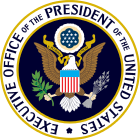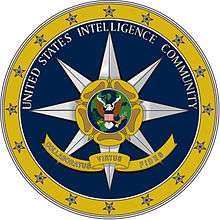United States National Security Council
 | |
| Agency overview | |
|---|---|
| Formed | September 18, 1947 |
| Agency executives | |
| Parent agency | Executive Office of the President of the United States |
| Website | NSC Website |

The White House National Security Council (NSC) is the principal forum used by the President of the United States for consideration of national security and foreign policy matters with senior national security advisors and Cabinet officials and is part of the Executive Office of the President of the United States. Since its inception under Harry S. Truman, the function of the Council has been to advise and assist the president on national security and foreign policies. The Council also serves as the president's principal arm for coordinating these policies among various government agencies. The Council has counterparts in the national security councils of many other nations.
History
The National Security Council was created in 1947 by the National Security Act. It was created because policymakers felt that the diplomacy of the State Department was no longer adequate to contain the USSR in light of the tension between the Soviet Union and the United States.[1] The intent was to ensure coordination and concurrence among the Army, Marine Corps, Navy, Air Force and other instruments of national security policy such as the Central Intelligence Agency (CIA), also created in the National Security Act.
On May 26, 2009, President Barack Obama merged the White House staff supporting the Homeland Security Council (HSC) and the National Security Council into one National Security Staff (NSS). The HSC and NSC each continue to exist by statute as bodies supporting the President.[2]
The decision process inside the structure has become less and less formal but influence of the Council has become stronger and stronger. Detailed history of the National Security Council under each Presidential administration since its inception can be found at:
Membership
The National Security Council is chaired by the President. Its members are the Vice President (statutory), the Secretary of State (statutory), the Secretary of Defense (statutory), the Secretary of Energy (statutory), the National Security Advisor (non-statutory), and the Secretary of the Treasury (non-statutory).
The Chairman of the Joint Chiefs of Staff is the statutory military advisor to the Council, the Director of National Intelligence is the statutory intelligence advisor, and the Director of National Drug Control Policy is the statutory drug control policy advisor. The Chief of Staff to the President, Counsel to the President, and the Assistant to the President for Economic Policy are also regularly invited to attend NSC meetings. The Attorney General, the Director of the Office of Management and Budget and The Director of the Central Intelligence Agency are invited to attend meetings pertaining to their responsibilities. The heads of other executive departments and agencies, as well as other senior officials, are invited to attend meetings of the NSC when appropriate.
| Structure of the United States National Security Council[3] | |
|---|---|
| Chair | President of the United States |
| Statutory Attendees[4] | Vice President of the United States Secretary of State Secretary of Defense Secretary of Energy |
| Military Advisor | Chairman of the Joint Chiefs of Staff |
| Intelligence Advisor | Director of National Intelligence |
| Drug Policy Advisor | Director of National Drug Control Policy |
| Regular Attendees | National Security Advisor White House Chief of Staff Deputy National Security Advisor Attorney General |
| Additional Participants | Secretary of the Treasury Secretary of Homeland Security White House Counsel Assistant to the President for Economic Policy Ambassador to the United Nations Director of Office of Management and Budget Homeland Security Advisor |
Staff
- Assistant to the President for National Security Affairs: Susan Rice
- Assistant to the President and Deputy National Security Advisor: Avril Haines
- Deputy National Security Advisor for Strategic Communications and Speechwriting: Ben Rhodes
- Deputy National Security Advisor for International Economic Affairs: Adewale Adeyemo
- Deputy Assistant to the President, Executive Secretary of the National Security Council and Chief of Staff: Suzy George[5]
- Deputy Assistant to the President, Deputy White House Counsel, and Legal Advisor to the National Security Council: Brian Egan
- Special Assistant to the President and Senior Director for Strategic Planning: Salman Ahmed
- Special Assistant to the President and Senior Director for Counterterrorism: Jen Easterly
- Special Assistant to the President and Senior Director for Defense Policy and Strategy: Troy Thomas
- Special Assistant to the President and Senior Director for International Economics: Rory MacFarquhar
- Special Assistant to the President and Senior Director for Weapons of Mass Destruction Terrorism and Threat Reduction: Laura S. H. Holgate
- Special Assistant to the President and Senior Director for Multilateral Affairs and Human Rights: Stephen Pomper
- Special Assistant to the President and Senior Director for Development and Democracy: Mary Beth Goodman
- Special Assistant to the President and Cybersecurity Coordinator: Michael Daniel[6]
- Special Assistant to the President and Senior Director for Non-Proliferation:
- Special Assistant to the President and Senior Director for Intelligence Programs: Brett Holmgren
- Special Assistant to the President and Senior Director for Energy and Climate Change: Paul Bodnar
- Special Assistant to the President and White House Coordinator for the Middle East, North Africa, and the Gulf Region: Rob Malley
- Special Assistant to the President and Senior Director for Iran, Iraq, Syria, and Gulf States: Jeffrey Prescott
- Special Assistant to the President and Senior Director for Israel, Egypt, and the Levant: Yael Lempert
- Special Assistant to the President and Senior Director for North Africa and Yemen: Eric Pelofsky
- Special Assistant to the President and Senior Director for African Affairs: Grant T. Harris
- Special Assistant to the President and Senior Director for Western Hemisphere Affairs: Mark Feierstein
- Special Assistant to the President and Senior Director for Europe: Charlie Kupchan
- Special Assistant to the President and Senior Director for Russia and Central Asia: Celeste Wallander
- Special Assistant to the President and Senior Director for the Central Region: Dennis Ross
- Special Assistant to the President and Senior Director for South Asia: Peter Lavoy
- Special Assistant to the President and Senior Director for Asia: Dan Kritenbrink
- Assistant to the President and Deputy National Security Advisor: Avril Haines
Authority
The National Security Council was established by the National Security Act of 1947 (PL 235 – 61 Stat. 496; U.S.C. 402), amended by the National Security Act Amendments of 1949 (63 Stat. 579; 50 U.S.C. 401 et seq.). Later in 1949, as part of the Reorganization Plan, the Council was placed in the Executive Office of the President.
The High Value Detainee Interrogation Group also reports to the NSC.[7]
Kill authorizations
A secret National Security Council panel pursues the killing of an individual, including American citizens, who has been called a suspected terrorist.[8] In this case, no public record of this decision or any operation to kill the suspect will be made available.[8] The panel's actions are justified by "two principal legal theories": They "were permitted by Congress when it authorized the use of military forces against militants in the wake of the attacks of September 11, 2001; and they are permitted under international law if a country is defending itself."[8]
National Security Advisor Susan Rice, who has helped codify targeted killing criteria by creating the Disposition Matrix database, has described the Obama Administration targeted killing policy by stating that "in order to ensure that our counterterrorism operations involving the use of lethal force are legal, ethical, and wise, President Obama has demanded that we hold ourselves to the highest possible standards and processes".[9]
Reuters has reported that Anwar al-Awlaki, an American citizen, was on such a kill list and was killed accordingly.[8]
On February 4, 2013, NBC published a leaked Department of Justice memo providing a summary of the rationale used to justify targeted killing of US citizens who are senior operational leaders of Al-Qa'ida or associated forces.[10]
See also
- Title 32 of the Code of Federal Regulations
- National Coordinator for Security, Infrastructure Protection and Counter-Terrorism
- National Security Medal
- Iran Contra
- Targeted killing
- Tower Commission
References
- ↑ Encyclopedia of American foreign policy, 2nd ed. Vol. 2, New York: Scribner, 2002, National Security Council, 22 April 2009
- ↑ In Security Shuffle, White House Merges Staffs
- ↑ Policy Directive 1 (PDD-1), White House, Feb 13, 2009
- ↑ "National Security Council". The White House. www.whitehouse.gov. Retrieved 4 April 2012.
- ↑ "White House Announces New Executive Secretary / Chief of Staff for the National Security Council Staff". The White House: President Barack Obama. 29 July 2014. Retrieved 11 September 2015.
- ↑ Rogin, Josh (March 19, 2013). "Liz Sherwood-Randall promoted to new White House position". The Cable, Foreign Policy Magazine. Retrieved 19 March 2013.
- ↑ "Elite High Value Interrogation Unit Is Taking Its First Painful Steps", by Ed Barnes, Fox News Channel, May 12, 2010
- 1 2 3 4 "Secret panel can put Americans on "kill list'". Reuters. 5 October 2011.
- ↑ John O. Brennan's April 2012 Wilson Center Speech: The Efficacy and Ethics of U.S. Counterterrorism Strategy (Transcript and Video).
- ↑ DOJ Whitepaper
Additional sources
- NSC page at the White House website
- Story on the NSC in Foreign Policy journal.
- Annual Report To Congress On White House Office Staff; Executive Office of the President, Wednesday, July 1, 2009
Further reading
- Ivo H. Daalder and I.M. Destler, In the Shadow of the Oval Office: Profiles of the National Security Advisers and the Presidents They Served—From JFK to George W. Bush Simon & Schuster; 2009, ISBN 978-1-4165-5319-9.
- Karl F. Inderfurth and Loch K. Johnson, eds. Fateful Decisions: Inside the National Security Council. Oxford University Press, 2004. ISBN 978-0-19-515966-0.
- James Peck (2006). Washington's China: The National Security World, the Cold War, and the Origins of Globalism. Amherst, MA: University of Massachusetts Press.
- David J. Rothkopf, Running The World: the Inside Story of the National Security Council and the Architects of American Power, PublicAffairs; 2006, ISBN 978-1-58648-423-1.
- Journey to the Center of the World: U.S. National Security Council – Arzın Merkezine Seyahat: ABD Ulusal Güvenlik Konseyi – Article on US NSC in Turkish
- Cody M. Brown, The National Security Council: A Legal History of the President's Most Powerful Advisers, Project on National Security Reform (2008).
- M. Kent Bolton, U.S. National Security and Foreign Policymaking after 9/11: Present at the Re-Creation, Rowman & Littlefield; 2007, ISBN 978-0-7425-4847-3.
External links
| Wikimedia Commons has media related to National Security Council. |
- Official National Security Council website
- History of the NSC from the White House at the Wayback Machine (archived March 12, 2008)
- Records of the National Security Council (NSC) in the National Archives
- White House Office, National Security Council Staff Papers, 1948–1961, Dwight D. Eisenhower Presidential Library
- Homeland Security Watch (www.HLSwatch.com) provides current details on the NSC as it pertains to homeland security.
- Works by United States National Security Council at Project Gutenberg
- Works by or about United States National Security Council at Internet Archive
